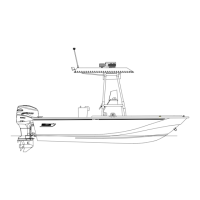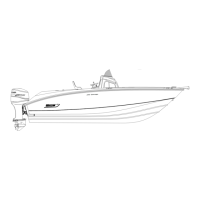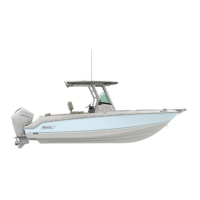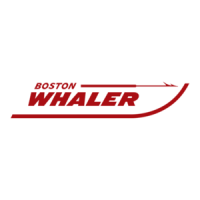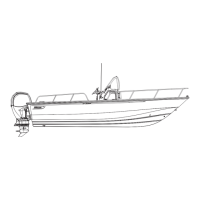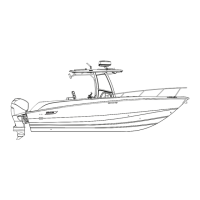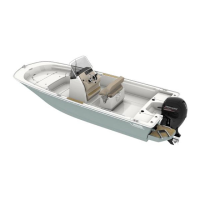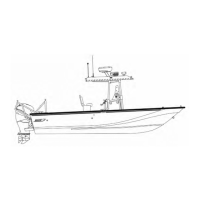
Do you have a question about the Boston Whaler 25 Guardian Series and is the answer not in the manual?
| Brand | Boston Whaler |
|---|---|
| Model | 25 Guardian Series |
| Category | Boat |
| Language | English |
Manual's purpose, copyright, and usage restrictions.
Details about the limited commercial warranty and product registration.
Defines operator's duties for safe boat operation and handling.
Explains "Good Samaritan" rule and how to assist distressed boaters.
Discusses PFD types, importance, and proper use for crew safety.
Warns about carbon monoxide dangers and essential safety precautions.
Details types, locations, and correct usage of fire extinguishers.
Discusses common causes of marine fires and response strategies.
Safety precautions for operating the boat in adverse weather conditions.
Explains the Emergency Position-Indicating Radio Beacon (EPIRB) and its function.
Information on capacity plates and adhering to load limits.
Discusses causes of capsizing and necessary preventative actions.
Explains causes of swamping and vital preventative measures.
Regulations and safety for boats engaged in diving operations.
Details the dive/rescue door, its operation, and related safety.
Information regarding California's Safe Drinking Water and Toxic Enforcement Act.
Guidelines for safe use of working and accommodation decks.
Diagram and list describing warning labels on the boat.
Checklist for preparing the boat before starting a mission.
Explains the function and operation of the ignition shutoff switch and lanyard.
Describes the function and operation of the main engine key switches.
Step-by-step guide for starting the outboard engines correctly.
Details operation of the dual-lever control for shifting and throttle.
Explains the neutral throttle feature on the dual-lever control.
How to control boat speed using the shift levers.
Explains engine trim adjustments for performance and efficiency.
Overview of various dashboard gauges and their functions.
Describes the tachometer's function in displaying engine speed (RPM).
Explains the hour meter for tracking engine operation time.
Describes the fuel gauge and how to read fuel levels.
Explains the water pressure gauge for cooling system monitoring.
Describes the voltmeter for checking battery voltage.
Explains the trim gauge and its relation to engine trim.
Overview of the Mercury Marine SmartCraft information system.
Information about propellers, selection, and maintenance.
Guidelines for proper placement of loads for safety and performance.
Checklist for properly shutting down the boat after use.
Guidelines and precautions for trailering the boat.
A checklist for verifying the condition of boat, trailer, and tow vehicle.
Guidelines and experience needed for towing a boat.
Instructions and tips for backing a trailer safely.
Safety warnings and procedures for lifting and slinging the boat.
Information on using factory-installed gunwale lifting eyes for moving the boat.
Guidelines for using a forklift to move the boat safely.
Critical safety precautions related to gasoline and the fuel system.
Overview of the boat's fuel system, tank, capacity, and components.
Illustrates the layout and components of the fuel system.
Details the Racor filters, their function, and maintenance.
Explains the fuel gauge and its electric sending unit.
Describes the optional fuel stripping pump and its use.
Explains the bonding system and procedures for its maintenance and repair.
Discusses issues and risks associated with contaminated gasoline.
Safety warnings and guidelines for refueling the boat.
Precautions to prevent static electricity discharge during fueling.
Additional important guidelines for safe fueling operations.
Information on using E-10 gasoline and its effects.
Introduces the section on boat systems, their functions, and usage.
Identifies and labels components on the boat's control console.
Explains the hydraulic steering system and its components.
Details the boat's navigation lights, their purpose, and operation.
Discusses magnetic compass, deviation, and variation.
How the compass and gauge lights operate at night.
Describes bilge pumps, sensors, and how to operate them.
Details the Lenco trim tab system, components, operation, and use.
Describes the 12 VDC signal horn and its USCG compliance.
Explains the battery status indicator panel and its LED.
Notes the bilge pump system's uninterruptible power supply exception.
Details the interior dome light for the console.
Describes the combination light fixture on the T-top.
Explains the function and control of 12 VDC floodlights.
Describes the red cockpit night lighting and its operation.
Information on the Whelen siren and strobe light system.
Details the ACR remote spotlight and its operation.
Overview of the boat's towing system and towing precautions.
Guidelines and safety for towing another boat.
Information and precautions for when the boat is being towed.
Explains the Electrical Leakage Circuit Interrupter (ELCI) safety feature.
Describes the sea water washdown system and its preparation for storage.
Explains the boat's 12 VDC electrical system and power distribution.
Discusses battery safety, handling, and storage precautions.
Details the types and capacities of the boat's batteries.
Explains how the engine alternators and battery charger charge the batteries.
Explains grounding and bonding systems, components, and RFI mitigation.
Explains the emergency battery parallel switch for starting assistance.
Describes the three battery switches and disabling them.
Notes the bilge pump system's uninterruptible power supply exception.
Overview of DC power distribution circuits and their protection.
Details power circuit for the starboard engine.
Details power circuit for the port engine.
Explains the uninterruptible power circuit for bilge pumps.
Describes the switch panel controlling basic boat systems.
Details the accessory fuse block for various boat systems.
Explains the fuse block located in the T-top radio box.
Describes the panel for sensitive communication and navigation systems.
A chart mapping wire colors to their respective systems.
Lists key physical and performance specifications of the boat.
Explains the location and importance of the HIN for identification.
Procedures for washing, waxing, compounding, and repairing the hull.
Guidelines for maintaining aluminum and deck hardware.
Inspecting and servicing hull fittings like scuppers and plates.
Explains the cause and formation of hull blistering (hydrolysis).
Protecting the hull via inspection, waxing, and bottom painting.
Preparing boat for storage and choosing/evaluating trailers.
Protecting fuel system and engines from moisture and temperature changes.
Maintenance recommendations for the manual hydraulic steering system.
Lists approved fluids for the hydraulic steering system.
Periodic battery maintenance, including inspection, cleaning, and storage.
Preparing boat systems, engines, and batteries for storage.
Outlines the hull and accessory warranty periods and stipulations.
